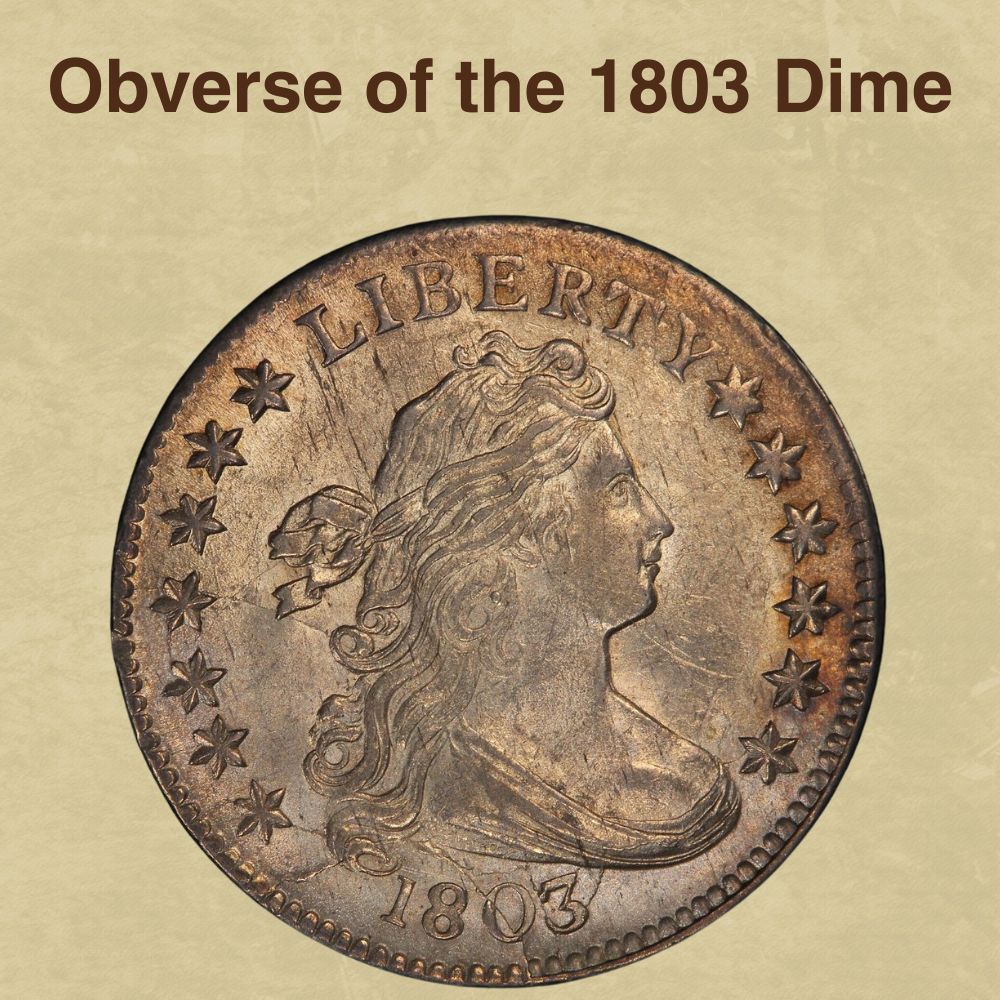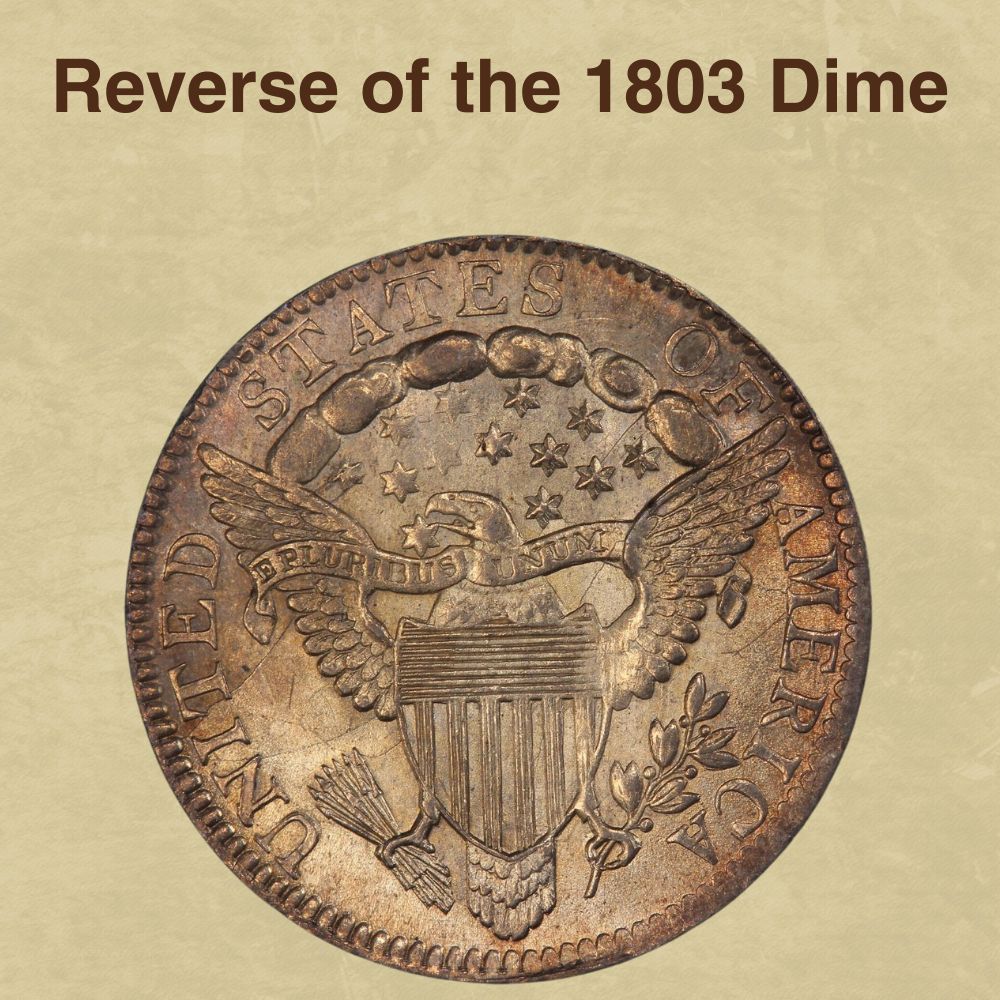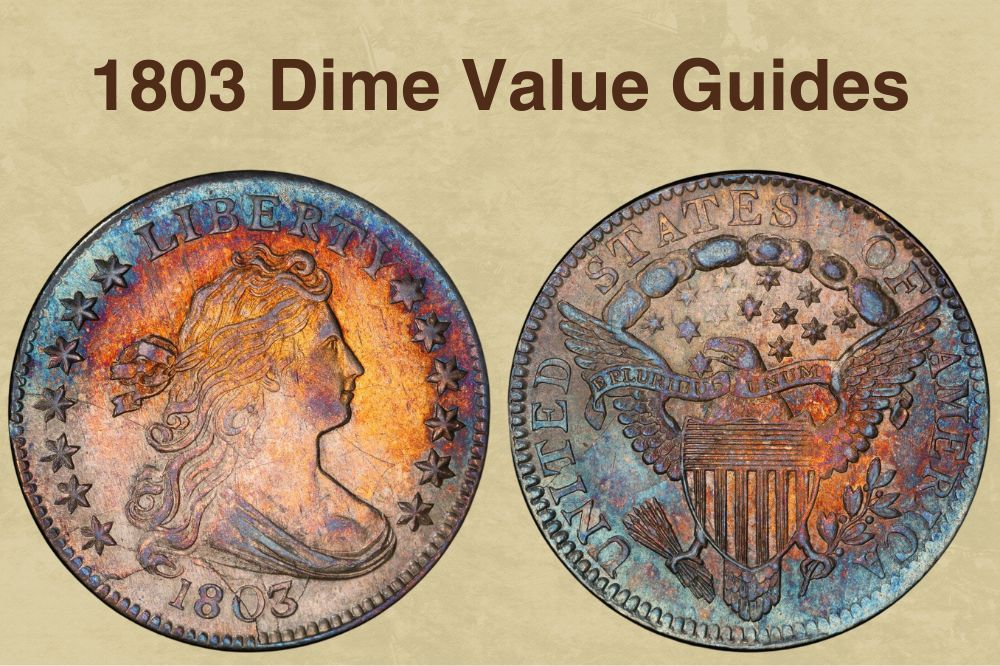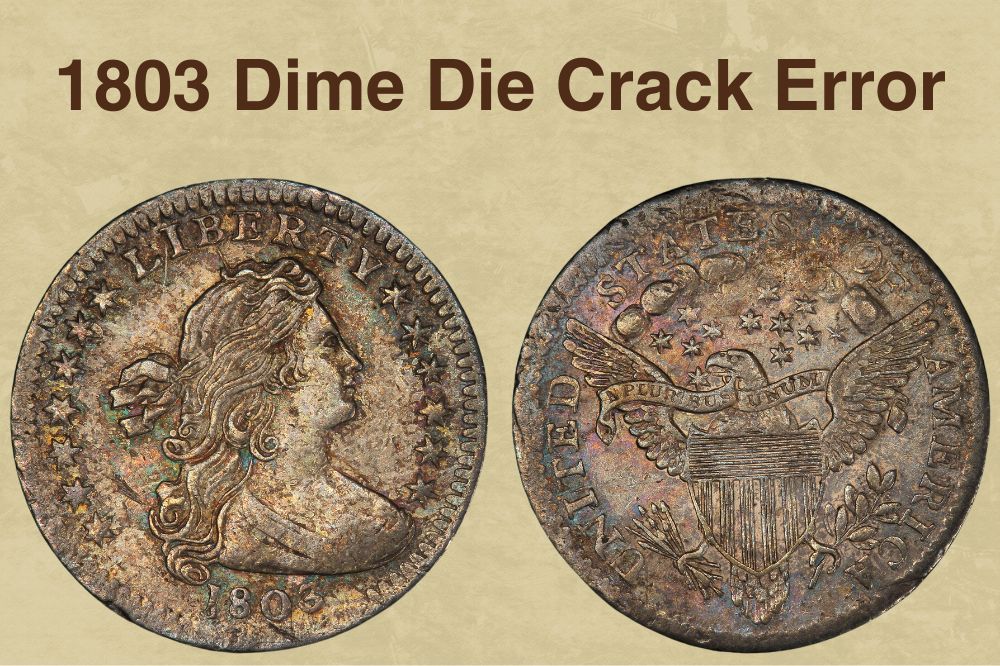Have you come across a 1803 Draped Bust dime and wonder whether it’s worth anything? Or, are you considering adding this iconic coin to your collection and are curious about its worth? Our comprehensive 1803 dime value guide will help!
In this guide, we’ll break down the value of circulated and uncirculated 1803 dimes and even reveal record-stomping auction prices for this coin. You’ll discover some of the most valuable minting errors worth collecting, identify the coin’s standout features, and learn how to grade your silver dime like a pro. If you’re a history buff, we’ve got you covered with a brief walk-through of the origins of the Draped Bust dime series.
Curious to find out how much is a 1803 dime value worth? Read on for all the details!
1803 Dime Value Chart |
||||
| Mint Mark | Good | Fine | Extremely Fine | Uncirculated |
| 1803 Dime Value | $1,200 | $2,000 | $8,000 | $322,000 |
History of the 1803 Dime
The 1803 dime is part of the popular Draped Bust coin series, which the United States Mint struck from 1796 to 1807, replacing the Flowing Hair Dollar. For a few years, there was mounting dissatisfaction with the Flowing Hair design, and in 1796, Congress responded to the widespread criticism, giving the Mint permission to strike a new design to replace the Flowing Hair design.
The Mint’s Chief Engraver, Robert Scot, swung into action to create a new design for the proposed coins. Scot transformed a portrait of a socialite by artist Gilbert Stuart, making Liberty’s portrait bustier and feminine. The socialite represented here is believed to be Ann Willing Bingham, a popular figure in the Philadelphia social scene and the wife of renowned statesman William Bingham. Scot’s portrayal of Lady Liberty remained the same throughout the Draped Bust dime series, with only a few changes to the portrait’s overall aesthetics.
At its inception, the Draped Bust series had three reverse designs. For the copper coins, the reverse showed the denomination, such as ONE CENT or HALF CENT, encircled by a wreath. This design changed in 1795, when a skinny bald eagle replaced the wreath and denomination image. This new design was known as the Draped Bust, Small Eagle, which has low mintages and therefore attracts significant premiums in all grades. A new design was introduced in 1798, where the scrawny eagle was replaced by the Heraldic eagle; this design is known as the Draped Bust, Heraldic eagle.
Only a few survivors of the 1803 Draped Bust dime exist today, but what makes this coin more fascinating is the fact that Mint State examples are virtually unknown. In the next sections, we’ll identify the standout features for grading 1803 dimes and find out how much this historic coin is worth.
Also read: Top 17 Most Valuable Roosevelt Dimes Worth Money
Features of the 1803 Dime
Knowing the key physical attributes of the 1803 dime can help you authenticate and grade your silver coin. Like many early silver coins, 1803 dimes are a target for counterfeiting, so familiarizing yourself with the features is essential for telling a fake from a real silver dime.
Here’s what to look out for:
Obverse of the 1803 Dime

The obverse side features Liberty’s right-facing portrait, in which she sports flowing, curly hair with a few strands held back by a ribbon. Liberty also adorns drapey clothing that highlights her bust, which is where the coin’s name is derived.
The word LIBERTY is etched above her while the date 1803 is shown below her portrait. Thirteen stars, seven to the left and six to the right, surround Liberty’s portrait and represent the first states to join the Union.
Reverse of the 1803 Dime

On the reverse is an image of the heraldic eagle with a shield on its breast. The shield is symbolic of strength in the unity between the federal and state governments, and also represents non-aggression.
In its right talon, the eagle holds arrows, which symbolize victory, while the olive branch in the left talon represents peace. Above the eagle’s head is a billow of clouds and a constellation of thirteen stars, which symbolize the original thirteen states of the union.
The words UNITED STATES OF AMERICA are inscribed around the rim. Like other dates in the series, indicating the coin’s value was not considered necessary, as this would be discerned from the coin’s size.
Other Features of the 1803 Dime
Additional features worth noting include:
- Diameter: 80 millimeters
- Weight: 70 grams
- Edge: Reeded
- Metal composition: 2% Silver, 10.8% Copper
- ASW: 0774oz
- Fineness: 892
1803 Dime Value Guides

So, how much is the 1803 dime worth? The value of this Draped Bust coin depends on its condition (grade) and scarcity. Although the estimated mintage of 1803 dimes is 33,040 pieces, some in the numismatic circle have speculated that this figure includes dimes dated 1802 and that the actual population of 1803-dated dimes is between 10,000 and 12,000.
Here’s a breakdown of the value of 1803 dimes:
- Circulated Examples: Although survivors are scarce and heavily worn, they can command premiums. The population of lower-grade 1803 dimes dips drastically from grade Very Fine (VF), which also corresponds to a large spike in the coin’s prices. In Poor/Average condition, examples can fetch as much as $800 and up to $1,200 in Good (G) condition. Very Good (VG) examples are worth about $1,600, Fine (F) ones can sell for up to $2,000, while Extremely Fine (XF) pieces will command up to $8,000. The finest known 1803 dimes are graded About Uncirculated (AU) and can fetch as much as $15,750 in AU53 and up to $41,500 in AU58.
- Mint State Examples: What sets the 1803-dated dimes apart is the extreme rarity of Mint State survivors. To date, only one uncirculated example is known, and that is the Parmelee-Atwater-Bareford-Lovejoy-Bolen-Price 1803 dime graded MS64. This lone coin boasts a mint luster, gold toning, and bold design details. A few minor scratches are seen on each side, and some areas of weakness are noticeable, especially where the shield meets the right wing. Five different die combinations produced the entire 1803 dime mintage, resulting in several varieties, some of which are rare and valuable. The MS64 specimen was auctioned in 2008 for a record-shattering $322,000.
- Auction Record: In 2002, Bowers & Merena auctioned an AU58 for a remarkable $48,300, making this one of the most valuable circulated examples of the 1803 Draped Bust dime.
Also read: Top 17 Most Valuable Mercury Dimes Worth Money
1803 Dime Grading
When grading a 1803 dime, examine the extent of wear, strike quality, and surface clarity. Start by checking the high-contact points that wear first, including Liberty’s hair above the forehead and behind the ear, inscriptions LIBERTY, date, and stars. On the reverse, examine the shield, wing, and tail feather details, as well as the talons. In lower grades, these details will be faint and even lacking a solid outline, while in finer grades, the details will be partially visible, and sharper with a bolder outline in higher circulated grades.
Draped Bust dimes, like many early coins, have a weak strike quality, even in higher-grade pieces. However, be careful not to confuse a weak strike with a lower grade—some higher-grade coins might still show strike weakness.
Lastly, check the surface quality for signs of damage. Extensive damage, such as dings, scratches, and corrosion, will lower the grade. Higher-grade dimes have fewer signs of damage and will show some surface luster, full denticles, and a noticeable brilliance that is missing from the duller, lower-grade pieces.
For more tips on grading the 1803 Draped Bust dime, check out this video.
Rare 1803 Dime Errors List
Five die varieties were used to strike the 1803 dimes, resulting in several minting errors and varieties. Not all of these errors are outstanding or valuable, but some are certainly worth collecting as they can raise the regular value of a Draped Bust dime.
Here are the most important 1803 dime errors worth money:
1. 1803 Dime Die Crack Error

Some 1803 dimes show a complex series of cracks on each side. Die cracks form as a result of a shattered or broken die surface; the impression of these breakages is transferred to the coin when metal flows and settles into the cracks on the die.
Larger, more dramatic die cracks are generally more valuable than smaller, subtle ones. In a 2004 sale, Stack’s Bowers auctioned a 1803 dime graded Fine (F) with obverse and reverse die cracks for $2,200.
2. 1803 Dime Overdate Error
Overdates are common on 18th to 20th century coins struck by hand. This error occurs when a new date is punched into a die containing an old or previous date, resulting in one or more of the date digits overlapping.
For example, mint workers might strike the date 1803 onto dies that struck 1802 dimes, resulting in traces of the number 2 appearing below the number 3. It takes a keen eye to notice an overdate, but this is undoubtedly one of the most fascinating minting errors.
An overdate is worth anything between $50 and $200 or more. For example, a collector on eBay paid $2,150 for a 1803 dime graded Fine (F) with an 1803/2 overdate error.
3. 1803 Dime Die Clash Error
A common error seen on 1803-dated dimes is the die clash, which occurs when the obverse and reverse dies clash against each other without a planchet between them. The pressure from the clash can cause the dies to impress their respective designs onto each other and then transfer the mixed design onto the planchet.
Coins with a die clash error will show the main design, such as Liberty’s portrait and a hint of the other die’s design, such as the heraldic eagle on the reverse. The result is a dramatic imagery that is thoroughly fascinating to collectors. A die clash error is worth anything from $100 to $200 or more, depending on the error’s visibility and the coin’s condition. For example, in a 2003 sale, Heritage Auctions sold a 1803 dime graded Fine (F) with an obverse and reverse die clash error for an impressive $2,300.
4. 1803 Dime Doubled Die Error
A doubled die error happens when the die strikes the planchet multiple times at slightly different positions. This results in visible doubling on the inscriptions and design elements on either side of the coin.
On Draped Bust dimes, doubling may occur on the inscription LIBERTY, date, and UNITED STATES OF AMERICA. Generally, the stronger or more visible the doubling, the more valuable the error tends to be. A doubled die error can raise the value of your dime by $50-$200 or more. For example, in 2007, a 1803 dime in Good (G) condition with an obverse and reverse doubled die error was auctioned on eBay for $1,300.
Where to Sell Your 1803 Dime?
Now that you know the value of your coins, do you know where to sell those coins online easily? Don’t worry, I’ve compiled a list of these sites, including their introduction, pros, and cons.
FAQs
How much is a 1803 dime worth?
The value of a 1803 Draped Bust dime depends on its condition. Circulated survivors are heavily worn but are scarce and will typically command higher-than-usual prices. Values of these worn examples range from $800 to $41,500. Mint State examples are extremely rare, with only one known existing example graded MS64 and valued at about $322,000.
Is a 1803 dime real silver?
Most of the metal content in a 1803 dime is silver. Specifically, this coin is made of 89.2% Silver and 10.8% Copper. You can perform the magnet test to authenticate your silver dime. Real silver is not magnetic, so your silver dime should not stick to the magnet. If you think you have a 1803 dime, you should have it authenticated by the Professional Coin Grading Service (PCGS) or the Numismatic Guaranty Company (NGC).
Is a 1803 dime worth collecting?
Yes. 1803-dated Draped Bust dimes are scarce in all grades, and certified and gradable survivors are valuable, even in lower grades. Whether selling or buying, this historical coin will command significant premiums.
The post 1803 Dime Coin Value: How Much Is It Worth Today? appeared first on CoinValueChecker.com.















